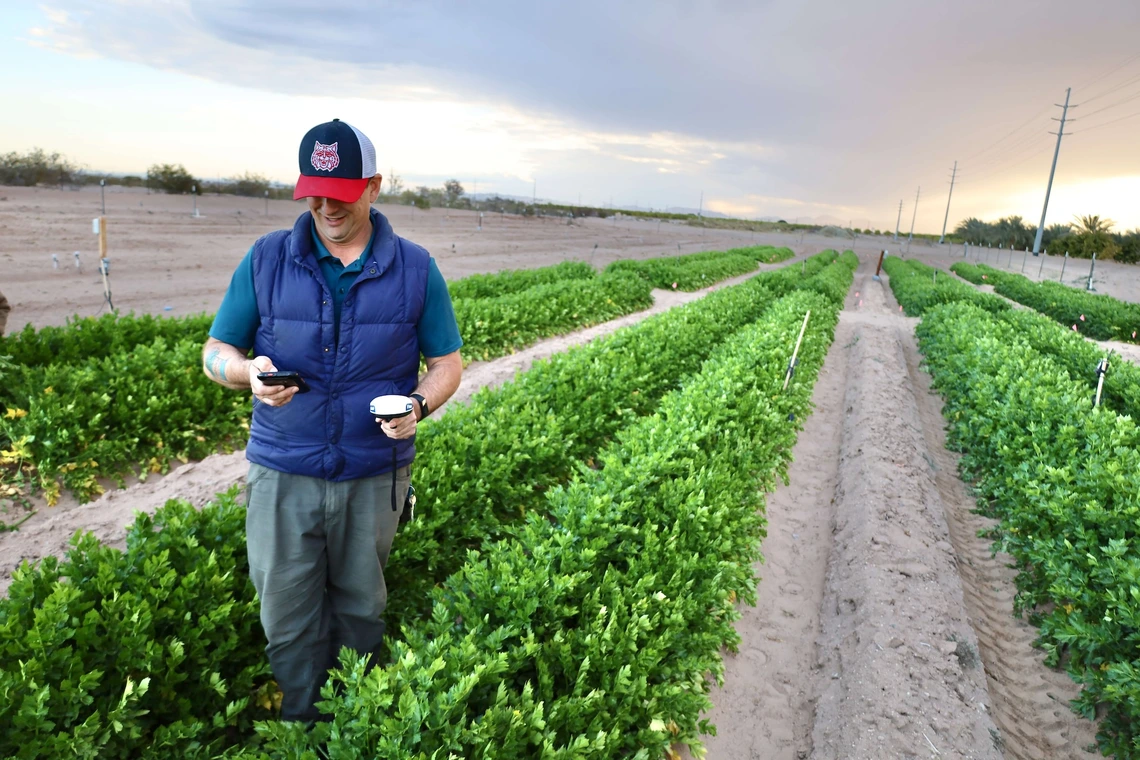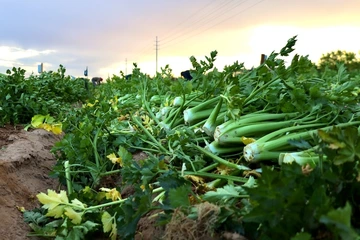University of Arizona study paves way toward water savings, increased crop yields
A study at the Yuma Agricultural Center is helping show that an emerging Norwegian technology can make dry, sandy soil productive.

Yuma County Assistant Extension Agent Robert Masson uses an optical sensor to track the condition of crops in a test plot of celery on the Yuma Mesa.
Cooperative Extension Assistant Agricultural Agent Robert Masson needed the worst land he could find for the first U.S. test of a Norwegian soil treatment designed to make dry, sandy soil more productive.
So he turned to the edge of the Yuma Mesa, where University of Arizona’s Yuma Agricultural Center researchers run arid-land trials on citrus, dates, and field crops. The half-acre parcel had never been commercially farmed or irrigated by the Colorado River. That means no nutrients had ever been added to the soil, naturally or by farmers.
It’s a perfect place to test “liquid natural clay,” an additive developed by the Norwegian company Desert Control. Their system pours nutrient-laden slurry onto sandy topsoil, helping the land hold water that would otherwise seep down beyond the reach of crops.

Brad Poole, Cooperative Extension
“We have a water crisis in the Southwest. We are over-budgeted for what we need, and so we can either learn how to apply less water to a crop or figure out how to keep the water near the roots, where it’s needed,” Masson said.
So far, they’ve grown romaine lettuce, celery, watermelons, and bell peppers – all donated to a local food bank. Masson is testing three different formulations of the clay slurry. Each harvest is weighed and logged to compare the yield among the three variations.
“In the lettuce, we saw a 20 to 50 percent yield increase (over untreated soil), given the same water and nutrition,” Masson said.
Adding clay to soil is not a new concept, but previous methods were prone to hardening soil into a cement-like conglomerate. Desert Control’s method breaks down mineral clay, making it water soluble. This allows the slurry to coat the grains of sand in a thin layer of clay that allows the soil to hold moisture without hardening, Masson said.
This five-year trial, which began in 2022, fits squarely within Extension’s mission to research new technologies, tell people about that research, then help farmers access the technology, Masson said.
The process involves no chemicals, and in June, the federal government approved the slurry for use in organic food production. Late last year, the company partnered with citrus grower Limoneira to test the process in Yuma and Cadiz, California. Earlier this year, the company partnered with produce company Yuma Organic on a Yuma Mesa commercial pilot project.
Desert Control President and CEO Ole Kristian Siversten hopes the Cooperative Extension and subsequent tests will prove the concept works in the U.S., opening up vast stretches of previously unfarmable desert to growers.
"There are 25,000 acres of irrigated land on the Yuma Mesa currently limited to a narrow range of crops due to its sandy soil. The successful transformation of sandy ground to high-value fertile land on the Yuma Mesa can inspire hope for the future of farming way beyond Yuma and Arizona,” Siversten said in a news release.

